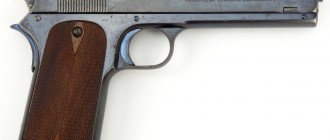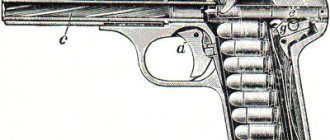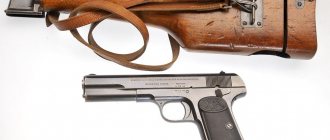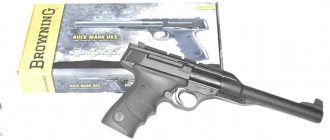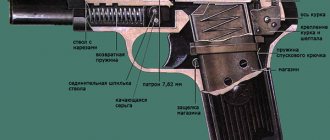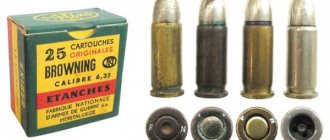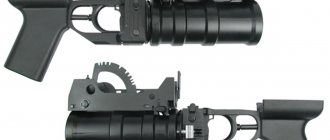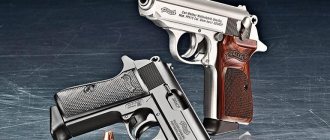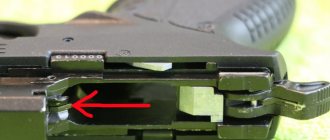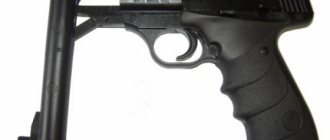Pistol FN Browning M 1906
| FN Browning M 1906 early model without safety catch |
In 1906, the Belgian company (FN) began serial production of the pocket, or according to the terminology of those times, “vest” 6.35 mm pistol FN Browning M 1906, intended for self-defense.
FN Browning M 1906 in use
Together with the Browning model 1906, the 6.35x15.5 HR (6.35 Browning) cartridge, created specifically for this weapon, also appeared on the market for the first time. In the USA, after Colt began producing a similar pistol, the 6.35x15.5 HR cartridge became known as the .25 ACP (Automatic Colt Pistol).
Technically, the FN Browning M 1906 was a smaller copy of the FN Browning M 1903 pistol, created by the legendary American gunsmith J.M. Browning, and differed only in the absence of a safety lever and the fact that instead of a hidden trigger, only a firing pin was present in the design. The size of the weapon was unusually small - the pistol easily fit in the palm of your hand.
On early models of the FN Browning M 1906, only an automatic safety was used, which was turned off when the weapon’s handle was properly grasped with the hand, and a magazine safety, which blocked the pistol in the absence of a magazine.
| FN Browning M 1906 with early release safety catch |
view of the back of the FN Browning M 1906 frame of different models without and with a safety pin.
After approximately 100,000 copies of this model were produced, a safety pin also appeared on the left rear of the frame, although it was intended rather to facilitate disassembly. After this, the pistol, which had frame, flag and magazine safeties, was sometimes called a “triple safety model.”
However, the design of the safety catch was soon changed and Fabrique Nationale began producing the FN Browning M 1906 of the third type. It was this type of pistol that became the main model, produced in quantities of about 1 million pieces.
In addition, a special model of this pistol was proposed, differing only in its elongated barrel, which protruded far beyond the muzzle of the bolt casing.
| FN Browning M 1906 with late release safety catch |
FN Browning M 1906 incomplete disassembly
The automatic operation of the FN Browning M 1906 pistol operates due to the recoil of the free bolt, and the barrel bore is locked by the mass of the bolt housing and the return spring.
The return spring is located under the barrel.
The trigger mechanism is striker type, single action, with a separate mainspring.
The safety lever is located on the left side at the end of the frame, and the automatic safety is located on the back wall of the handle.
The weapon is fed with ammunition from a detachable box-type magazine with a single-row arrangement of 6 rounds. The magazine release is located at the bottom of the handle.
Sights are open type, permanent, and consist of a front sight and rear sight.
The cheeks of the handle, made of plastic, were decorated with the Fabrique Nationale monogram of intertwined letters F and N.
| FN Browning M 1906 pistol parts |
In its early days, the FN Browning M 1906 pistol was affectionately called the “Baby Browning”, but this name was later officially assigned to the later FN model.
| Caliber, mm | 6.35x15.5 |
| Length, mm | 114 |
| Height, mm | 78 |
| Width, mm | 24 |
| Barrel length, mm | 54 |
| Weight without cartridges, kg | 0.380 |
| Store, count. cartridges | 6 |
| Initial bullet speed, m/s | 210 |
The Browning pistol of 1906 surpassed its two previous models in popularity, and its production amounted to millions of units. By the beginning of the First World War in 1914, 503,434 pistols had been manufactured. By the beginning of World War II, pistol production had ceased, and the total number of FN Browning M 1906 produced was about 1,200,000.
Since 1908, the same pistol (with very minor differences) was produced in the USA under the name Colt M 1908.
The fairly successful design of the Browning Model 1906 pistol and its manufacturability prompted other manufacturers to copy this system. A particularly large number of imitations were made by numerous arms companies from the Spanish city of Eibar, which because of this are collectively called the “Eibar type”.
The popularity of the Browning pocket pistol was so great at one time that any small “ladies’” pistol began to be called “Browning”. And indeed, despite the predilection for this model of military officers, the pistol easily fit into an elegant handbag. Pistols even began to be finished with mother-of-pearl and engraving. And less militant men were offered lighters made in the shape of Brownings of the 1906 model.
| FN Browning M 1906 with extended barrel |
Browning M1906 mmg pistol mockup
In 1906, the Belgian company (FN) began serial production of the pocket, or according to the terminology of those times, “vest” 6.35 mm pistol FN Browning M 1906, intended for self-defense. FN Browning M 1906 FN Browning M 1906 in use Together with the Browning model 1906, the 6.35x15.5 HR (6.35 Browning) cartridge, created specifically for this weapon, also appeared on the market for the first time. In the USA, after Colt began producing a similar pistol, the 6.35x15.5 HR cartridge became known as the .25 ACP (Automatic Colt Pistol). Technically, the FN Browning M 1906 was a smaller copy of the FN Browning M 1903 pistol, created by the legendary American gunsmith J.M. Browning, and differed only in the absence of a safety lever and the fact that instead of a hidden trigger, only a firing pin was present in the design. The size of the weapon was unusually small - the pistol easily fit in the palm of your hand. On early models of the FN Browning M 1906, only an automatic safety was used, which was turned off when the weapon’s handle was properly grasped with the hand, and a magazine safety, which blocked the pistol in the absence of a magazine.
| Caliber, mm | 6.35x15.5 |
| Length, mm | 114 |
| Height, mm | 78 |
| Width, mm | 24 |
| Barrel length, mm | 54 |
| Weight without cartridges, kg | 0.380 |
| Store, count. cartridges | 6 |
| Initial bullet speed, m/s | 210 |
The cartridges were created specifically for this model. Jacketed bullet, smokeless gunpowder (3 times more powerful than smoke gunpowder). Such a cartridge was more powerful than a revolver cartridge of the same caliber. Browning's 1906 model was very successful. The dimensions of the pistol were only 11.4 x 5.3 cm and it easily fit in the palm of your hand. What else was needed for a safe trip to the market??? Market traders were armed before the revolution. It is not surprising that the concept of “racketeering” was completely absent in those days... Browning could be worn secretly - it could even fit in a vest pocket and a lady’s travel bag. Because of its light weight and low recoil, women willingly bought it, and the name “ladies' pistol” was firmly attached to it. Browning was a popular model among large sections of Russian society for many years. Students, high school students, students, businessmen, diplomats, even officers - even gardeners! — had it at hand. Thanks to its low price, it was available even to schoolchildren, and teachers noted the fashion among high school students and students to “shoot because of unhappy love.” Small-caliber pistols were also called “suicide weapons.” Large-caliber pistols smashed the head like a pumpkin, and after a shot in the head from Browning, the dead man looked good in the coffin, which should have led to tears of remorse from the unfaithful traitor... But Browning was dangerous not only for its owner. It was an effective weapon of self-defense. A small-caliber shell bullet pierced a layer of muscle and got stuck inside the body, completely giving it its energy. The level of medicine at the beginning of the twentieth century often did not allow saving a person struck in the internal organs. Thanks to its compact size and its fighting qualities, the Browning Model 1906 was a popular model. In total, more than 4 MILLION pieces were made! But how did they look at “exceeding the limits of necessary defense” in tsarist times?? The term “necessary defense” first appeared in the decree of Paul I (whom our citizens often imagine as almost half-crazy) and it meant something completely different from what we are all used to. In the 18th century in Russia there was such a robbery industry - river piracy. Gangs of vagabonds attacked and robbed riverboats sailing along the main rivers. Emperor Paul I adopted a decree on the strict deprivation of the nobility of all nobles who were attacked on the rivers and did not offer armed resistance. The nobles then naturally had swords, and if they did not carry out the NECESSARY DEFENSE, they were deprived of this sword, as well as their estates and titles... Thanks to this formulation of the issue, in a very short time the robbers were killed or fled and robbery on the rivers stopped. That is, the necessary defense was the NECESSITY for the armed man to DEFEND. Naturally, there were no “limits”. In Soviet times, this useful concept was distorted and, if it occurs, it is only in the combination “EXCEEDING THE LIMITS OF NECESSARY DEFENSE.” A criminal offense was introduced for armed resistance to robbers, and the weapons themselves were taken away from the population. The Bolsheviks confiscated weapons from the population. To completely “disarm the bourgeoisie,” detachments of the Red Guard and Soviet police did a lot of work, conducting mass searches. However, some irresponsible “kulaks,” as we see, were in no hurry to part with Brownings until the mid-30s. And I understand them, a beautiful and necessary thing... A pistol from an everyday item has since turned into a symbol of belonging to the security forces or the highest party elite in the USSR. The caliber of a pistol was inversely proportional to one's position in society. (The higher the official, the smaller the caliber of his pistol.) ...This Browning model was so popular that it gradually went out of circulation only with the creation of the Korovin pistol in 1926. Compared to the Browning, its cartridge was strengthened and the barrel was slightly lengthened, and the magazine capacity increased to 8 rounds. It is interesting that despite its small caliber, it enjoyed great success among the command staff of the Red Army. Despite the current prejudice against small calibers, 6.35 caliber pistols are quite lethal and dangerous weapons. As we remember, it was from a Belgian 6.35 caliber pistol (“Bayard”) that Larisa Gruzdeva was killed, whose murder was investigated by Gleb Zheglov and Volodya Sharapov in the epic “The Meeting Place Cannot Be Changed.” A quite typical situation of those times was described. For a long time, pocket “award” pistols of 6.35 caliber put the finishing touches on family and love affairs. The need for a compact and lightweight pistol remains to this day. Nowadays, such a pistol is the PSM 5.45 mm caliber, which was used by party functionaries in Soviet times, and today by diplomats and government officials. officials. Its weight, 460 grams, does not weigh much on the pockets of big bosses. The dimensions of this pistol are 15x8 cm, and the thickness is only 1.8 cm, which allows you to carry it in a folder for papers. Any bureaucracy is only worth something when it knows how to defend itself... And all that remains for the ordinary Russian man in the street, exhausted by street crime, is to look longingly at the pages of pre-revolutionary magazines:
Jacketed bullet, smokeless gunpowder (3 times more powerful than smoke gunpowder). Such a cartridge was more powerful than a revolver cartridge of the same caliber. Browning's 1906 model was very successful. The dimensions of the pistol were only 11.4 x 5.3 cm and it easily fit in the palm of your hand. What else was needed for a safe trip to the market??? Market traders were armed before the revolution. It is not surprising that the concept of “racketeering” was completely absent in those days... Browning could be worn secretly - it could even fit in a vest pocket and a lady’s travel bag. Because of its light weight and low recoil, women willingly bought it, and the name “ladies' pistol” was firmly attached to it. Browning was a popular model among large sections of Russian society for many years. Students, high school students, students, businessmen, diplomats, even officers - even gardeners! — had it at hand. Thanks to its low price, it was available even to schoolchildren, and teachers noted the fashion among high school students and students to “shoot because of unhappy love.” Small-caliber pistols were also called “suicide weapons.” Large-caliber pistols smashed the head like a pumpkin, and after a shot in the head from Browning, the dead man looked good in the coffin, which should have led to tears of remorse from the unfaithful traitor... But Browning was dangerous not only for its owner. It was an effective weapon of self-defense. A small-caliber shell bullet pierced a layer of muscle and got stuck inside the body, completely giving it its energy. The level of medicine at the beginning of the twentieth century often did not allow saving a person struck in the internal organs. Thanks to its compact size and its fighting qualities, the Browning Model 1906 was a popular model. In total, more than 4 MILLION pieces were made! But how did they look at “exceeding the limits of necessary defense” in tsarist times?? The term “necessary defense” first appeared in the decree of Paul I (whom our citizens often imagine as almost half-crazy) and it meant something completely different from what we are all used to. In the 18th century in Russia there was such a robbery industry - river piracy. Gangs of vagabonds attacked and robbed riverboats sailing along the main rivers. Emperor Paul I adopted a decree on the strict deprivation of the nobility of all nobles who were attacked on the rivers and did not offer armed resistance. The nobles then naturally had swords, and if they did not carry out the NECESSARY DEFENSE, they were deprived of this sword, as well as their estates and titles... Thanks to this formulation of the issue, in a very short time the robbers were killed or fled and robbery on the rivers stopped. That is, the necessary defense was the NECESSITY for the armed man to DEFEND. Naturally, there were no “limits”. In Soviet times, this useful concept was distorted and, if it occurs, it is only in the combination “EXCEEDING THE LIMITS OF NECESSARY DEFENSE.” A criminal offense was introduced for armed resistance to robbers, and the weapons themselves were taken away from the population. The Bolsheviks confiscated weapons from the population. To completely “disarm the bourgeoisie,” detachments of the Red Guard and Soviet police did a lot of work, conducting mass searches. However, some irresponsible “kulaks,” as we see, were in no hurry to part with Brownings until the mid-30s. And I understand them, a beautiful and necessary thing... A pistol from an everyday item has since turned into a symbol of belonging to the security forces or the highest party elite in the USSR. The caliber of a pistol was inversely proportional to one's position in society. (The higher the official, the smaller the caliber of his pistol.) ...This Browning model was so popular that it gradually went out of circulation only with the creation of the Korovin pistol in 1926. Compared to the Browning, its cartridge was strengthened and the barrel was slightly lengthened, and the magazine capacity increased to 8 rounds. It is interesting that despite its small caliber, it enjoyed great success among the command staff of the Red Army. Despite the current prejudice against small calibers, 6.35 caliber pistols are quite lethal and dangerous weapons. As we remember, it was from a Belgian 6.35 caliber pistol (“Bayard”) that Larisa Gruzdeva was killed, whose murder was investigated by Gleb Zheglov and Volodya Sharapov in the epic “The Meeting Place Cannot Be Changed.” A quite typical situation of those times was described. For a long time, pocket “award” pistols of 6.35 caliber put the finishing touches on family and love affairs. The need for a compact and lightweight pistol remains to this day. Nowadays, such a pistol is the PSM 5.45 mm caliber, which was used by party functionaries in Soviet times, and today by diplomats and government officials. officials. Its weight, 460 grams, does not weigh much on the pockets of big bosses. The dimensions of this pistol are 15x8 cm, and the thickness is only 1.8 cm, which allows you to carry it in a folder for papers. Any bureaucracy is only worth something when it knows how to defend itself... And all that remains for the ordinary Russian man in the street, exhausted by street crime, is to look longingly at the pages of pre-revolutionary magazines:
